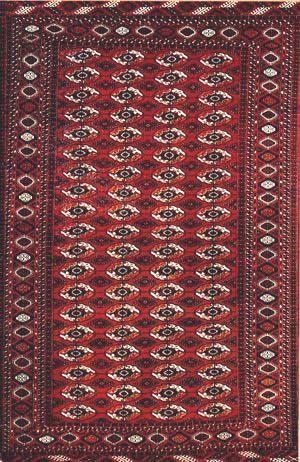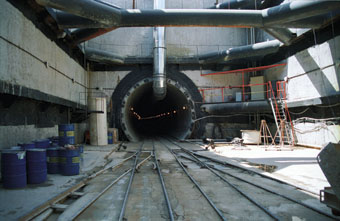Turkmen carpet weaving
Topic: Turkmen Traditions

Turkmen arts and crafts witnessed uneven development of various specialties. They had high esthetic and technical qualities, especially among herders. This included embroidery of clothing, especially wool leggings - jorab, purses and carpets.
Turkmen carpets are especially famous. They were produced by all tribes in present-day Turkmenistan with the exception of the non-Turkmen nukhurli tribes.
A Turkmen carpet is not only a work of art, but also a necessary thing for every day life. The carpets had their own uses: haly - carpets for decoration of dwellings; namazlyk - small carpets for prayer; and gapykilim, ensi - medium sized carpets used for curtaining of entrance and yurts. Besides that, carpet goods included different bags - torba, which people used to hang on the walls of buildings or yurts for keeping house utensils; other bags - chuval, maprach - for dresses, clothes and other belongings. At the same time these bags were used with a decorative purposes, such as saddle bags - horzuun, and finally, there were decorative ornaments - osmaldyk, halyk - for camel bale, as well as various carpet bands - akyup, golan (polam) 10-15m in length and 20-40m in width used for decorating inside walls of yurts and for fixing outside felt covers.
The carpets of separate large tribes were different in their patterns and manufacturing styles. The most popular ones belonged to tekins (Turkomen) and pendins (salyrs). Though yomut carpets were original and have beautiful patterns and colors, they were not so popular in the world market. All Turkmen carpets are similar in colorings and style, and differ from other national carpets. The major color of Turkmen carpets is red, and the color spectrum goes from dark-cherry (pendin carpets) to scarlet (tekins). Other colors used are black and white, and yomuts used blue color for carpets as well. White gradually becomes ivory, and red colors slightly fade, giving old carpets a specific lightness and coloring harmony.
By the end of the 19th c, the Turkmen used only natural, very strong dyes for coloring of wool. Later they started to use cheaper, weaker aniline dyes, which considerably affected the color range. The patterns had a geometrical shape, and each big tribe had its own distinctive type. Big carpets have a clearly visible division on the central part and borders. In the center one can see octagonal figures and rhombs filled in with patterns. Yomut carpets have patterns like cogged rhomb-shaped rosettes. According to the opinion of carpet expert Moshkova V.G the central pattern, called gel', represented the tribe emblem with the image of a totem in the old days.
The edging consists of ordinary conventionalized geometrical, and sometimes plant motives. The carpets produced at the end of the 19th c and beginning of the 20th c do not contain very many geometrical shapes of animals and plants. Old carpets manufactured hundred years ago were showing everyday life scenes. The yomut strips of carpet were especially interesting in this regard. They showed migration and other scenes. The museum of ethnography of the USSR in St Petersburg keeps an old yomut strip of carpet which reflects a return from a foray - alaman. The modern yomut carpets also contain geometrical plant patterns.
The Turkmen carpets can be divided into fleecy (chitme technique) and non-fleecy (kakma technique). Along with these main types, there are intermediate type, where fleecy patterns are made on a non-fleecy background.
In fact the carpets, carpet bags and decorations for camels are produced in a fleecy way. The Turkmen fleecy carpets are of a high quality; they have thick knots and a short nap. Yomuts are mostly non-fleecy. They include big floor covers, kit-bags - chuval, as well as carpet strips for surrounding wooden frames of yurts and outside cane mats (duzi, bilyup, etc.). However the most beautiful carpet strips, which are now very rare, had patterns on a non-fleecy background. This was the way yomuts produced golan and akyup carpet strips. Strips had very specific drawings: their geometrical pattern goes on white background and changes along the whole length several times. The main picture of this pattern reminds one of a branching tree, strongly conventionalized. These combined strips are very close to Karakalpak ones. Significantly often the Turkmen start using other type of strips for securing yurts: they have colored patterns on a white background. In spite of the variety of carpet forms, the manufacture techniques were not complicated. The carpets were produced on a horizontally installed loom, a very ordinary device.
Two pairs of stakes were hammered into the ground according to the size of the planned carpet. Behind the stakes there were fixed two beams for stretching the main part of the carpet. For thread shifting they used a stick with loops catching one part of the base, and a small board. A stick with loops was installed on forks hammered into the ground, or on handmade loam columns. In order to keep base threads immovable, they fixed them by loam to the stick. Woof thread was taken through by hand without a shuttle. For hammering the woof, people used a massive iron comb with a wooden handle. They cut the nap with scissors made by local craftsmen.
This delicate technique did not allow fast work. It took a month of hard work for a Turkmen woman to weave a 4-5 m carpet. For wide carpets, several women worked, sitting in a row.
During cold times the loom was installed inside a special yurt. In summer it was installed under a shed. Mainly, carpets were produced during the warm period of the year, as it was difficult to work in winters. Threads were made gradually, and mainly of sheep wool cut in spring.
Now carpet weaving is becoming more popular but is done in special artels. Weavers have learned new techniques (vertical weaving) and new patterns. The carpets are made to order.
Felt Felt works are also made, but are not so outstanding as those of the Kazakhs, Kirgiz and Karakalpaks.
Reed mats are used as frames. Layers of wool are spread, soaked and rolled on them. The mat is tied round with a rope and the rolling continues, sometimes with the help of a horse. The felt is removed, turned over and rolled by hand.
The mats are used as bedding and cover for the lower part of the yurt, with the felt on top. They are woven on primitive devices with thick thread. This is different from techniques of the Uzbeks and Tajiks. Their nomadic lifestyle gave preference to felt ornament on carpets and purses - keche.
Ornamented felts - keche - have extremely interesting and peculiar patterns. The main pattern, which frames the central part, is called sary ichyan (yellow scorpion), saylan (election) or gochak (ram horn). The central field is usually occupied by 2-4 large circles, which have different names in various tribes. The central pattern's name is the name of the felt. Yomut-djafarbays and inhabitants of the Caspian Sea coast have two-sided ornamented felts - goshma keche. The local crafts women are considered to be the most skillful in making felts. Felt items by Turkmen-Saryks were especially prized. They are produced in settled areas now as well. Turkmen herders of sheep produced the most felt, both monotone and ornamented.
The manufacturing process is mainly the same like in other regions of Central Asia; felt production is only a women's occupation.
New ornaments are now used. Carpet making became an industry, but it is still done as a handicraft.
Source: http://intangiblenet.freenet.uz
Posted by countryturkmenistan
at 12:16 PM

 Turkmen arts and crafts witnessed uneven development of various specialties. They had high esthetic and technical qualities, especially among herders. This included embroidery of clothing, especially wool leggings - jorab, purses and carpets.
Turkmen arts and crafts witnessed uneven development of various specialties. They had high esthetic and technical qualities, especially among herders. This included embroidery of clothing, especially wool leggings - jorab, purses and carpets.  Ukrainian specialists are laying down the unique communication and drainage tunnel
Ukrainian specialists are laying down the unique communication and drainage tunnel